MGT 411: Case Study Analysis of Nissan Leadership Strategies
VerifiedAdded on 2022/08/23
|6
|1343
|19
Case Study
AI Summary
This document is a comprehensive case study analysis of the leadership strategies employed at Nissan under Carlos Ghosn. The analysis addresses key questions regarding Ghosn's approach to consensus-building, his strategies for addressing issues within vertical and horizontal management structures, and his capacity for global leadership. The study examines Ghosn's leadership style, including his use of communication, employee motivation, and the implementation of cross-functional teams to achieve organizational change. The analysis highlights the factors that contributed to Ghosn's success, such as recognizing problems and implementing effective strategies, as well as the use of examples to inspire employees. The case study draws upon references to support its findings and provides a detailed overview of Nissan's transformation under Ghosn's leadership.

Running Head: Question and Answer on Case Analysis
QUESTION AND ANSWER ON CASE ANALYSIS
Name of the Student
Name of the University
Authors Note
QUESTION AND ANSWER ON CASE ANALYSIS
Name of the Student
Name of the University
Authors Note
Paraphrase This Document
Need a fresh take? Get an instant paraphrase of this document with our AI Paraphraser
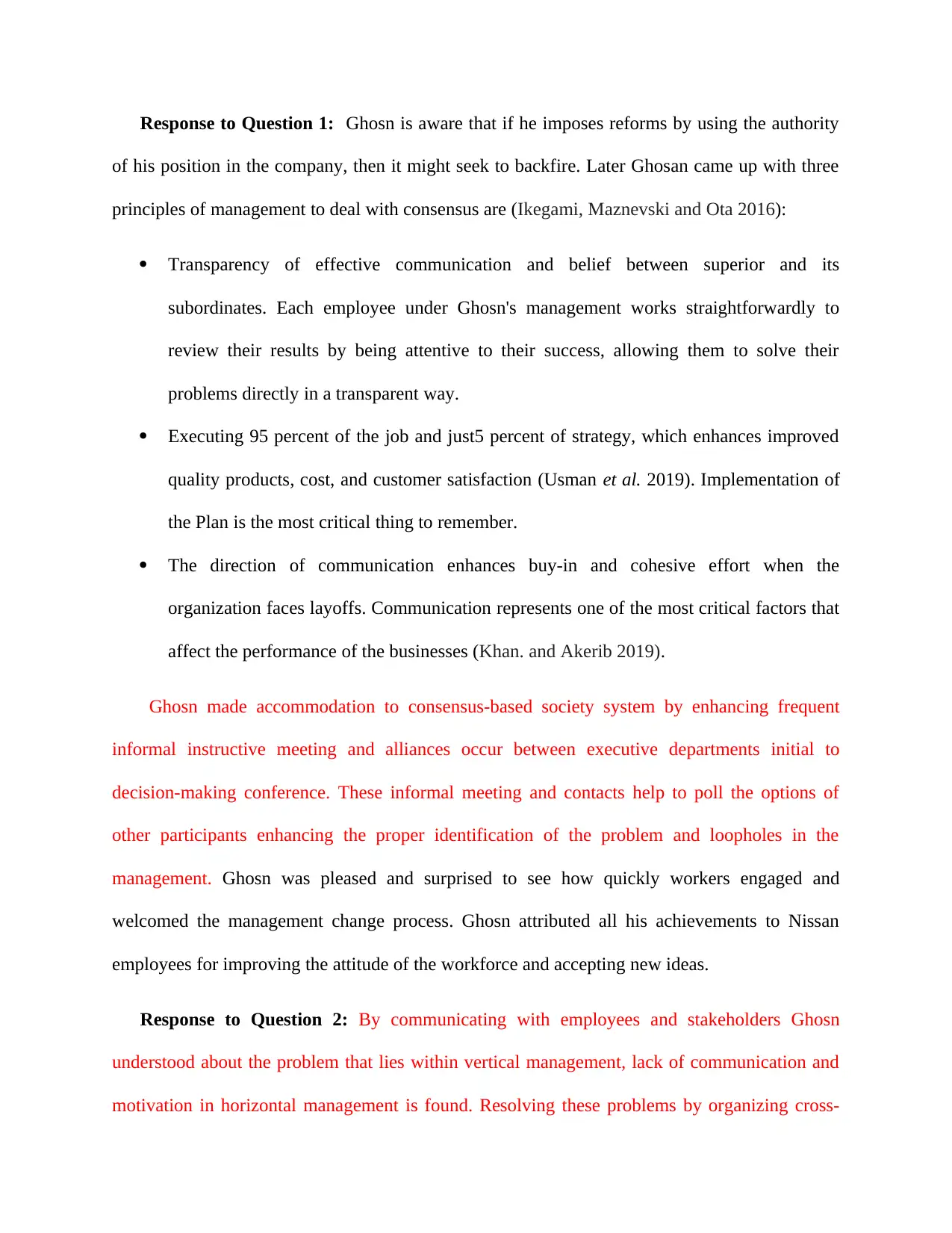
Response to Question 1: Ghosn is aware that if he imposes reforms by using the authority
of his position in the company, then it might seek to backfire. Later Ghosan came up with three
principles of management to deal with consensus are (Ikegami, Maznevski and Ota 2016):
Transparency of effective communication and belief between superior and its
subordinates. Each employee under Ghosn's management works straightforwardly to
review their results by being attentive to their success, allowing them to solve their
problems directly in a transparent way.
Executing 95 percent of the job and just5 percent of strategy, which enhances improved
quality products, cost, and customer satisfaction (Usman et al. 2019). Implementation of
the Plan is the most critical thing to remember.
The direction of communication enhances buy-in and cohesive effort when the
organization faces layoffs. Communication represents one of the most critical factors that
affect the performance of the businesses (Khan. and Akerib 2019).
Ghosn made accommodation to consensus-based society system by enhancing frequent
informal instructive meeting and alliances occur between executive departments initial to
decision-making conference. These informal meeting and contacts help to poll the options of
other participants enhancing the proper identification of the problem and loopholes in the
management. Ghosn was pleased and surprised to see how quickly workers engaged and
welcomed the management change process. Ghosn attributed all his achievements to Nissan
employees for improving the attitude of the workforce and accepting new ideas.
Response to Question 2: By communicating with employees and stakeholders Ghosn
understood about the problem that lies within vertical management, lack of communication and
motivation in horizontal management is found. Resolving these problems by organizing cross-
of his position in the company, then it might seek to backfire. Later Ghosan came up with three
principles of management to deal with consensus are (Ikegami, Maznevski and Ota 2016):
Transparency of effective communication and belief between superior and its
subordinates. Each employee under Ghosn's management works straightforwardly to
review their results by being attentive to their success, allowing them to solve their
problems directly in a transparent way.
Executing 95 percent of the job and just5 percent of strategy, which enhances improved
quality products, cost, and customer satisfaction (Usman et al. 2019). Implementation of
the Plan is the most critical thing to remember.
The direction of communication enhances buy-in and cohesive effort when the
organization faces layoffs. Communication represents one of the most critical factors that
affect the performance of the businesses (Khan. and Akerib 2019).
Ghosn made accommodation to consensus-based society system by enhancing frequent
informal instructive meeting and alliances occur between executive departments initial to
decision-making conference. These informal meeting and contacts help to poll the options of
other participants enhancing the proper identification of the problem and loopholes in the
management. Ghosn was pleased and surprised to see how quickly workers engaged and
welcomed the management change process. Ghosn attributed all his achievements to Nissan
employees for improving the attitude of the workforce and accepting new ideas.
Response to Question 2: By communicating with employees and stakeholders Ghosn
understood about the problem that lies within vertical management, lack of communication and
motivation in horizontal management is found. Resolving these problems by organizing cross-
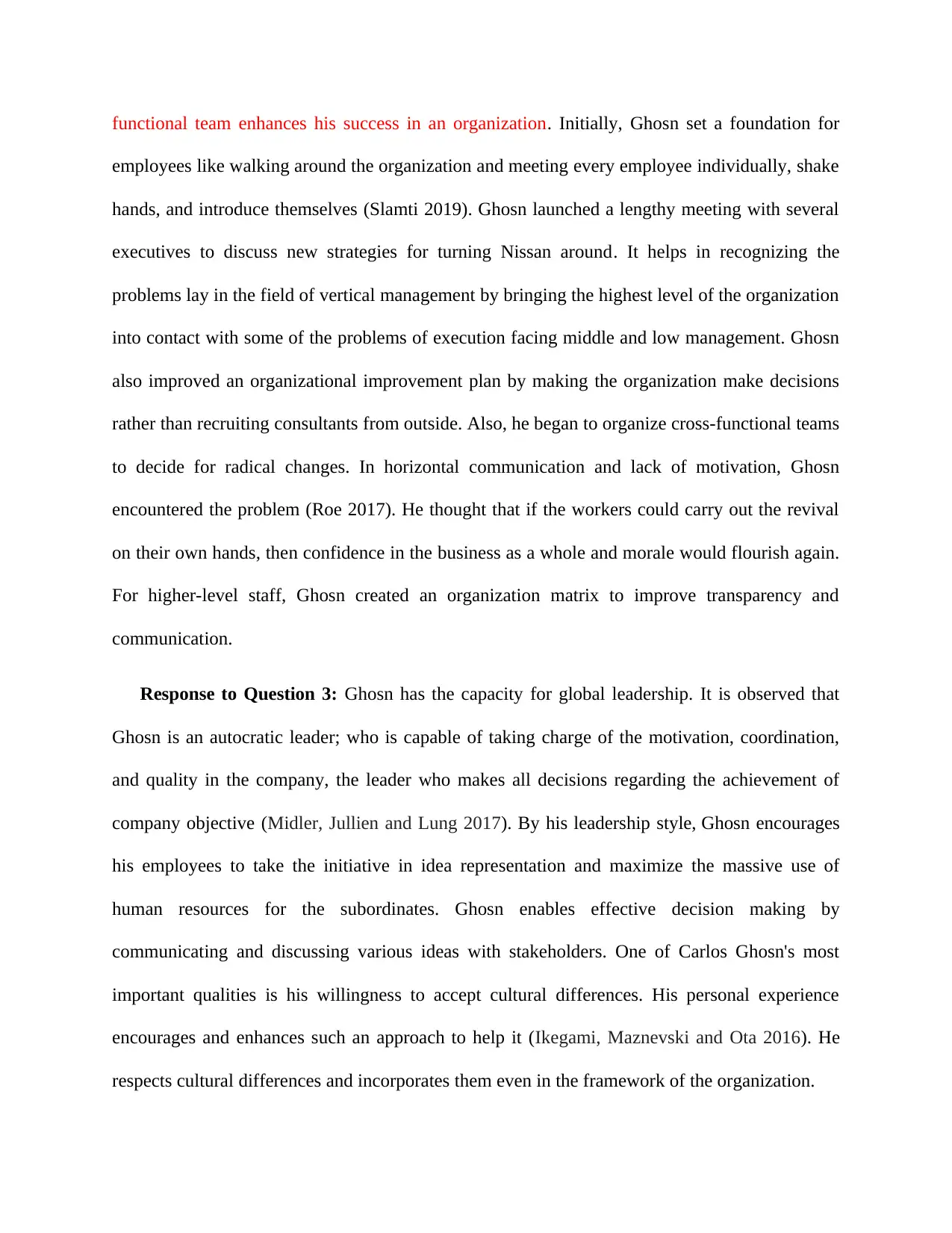
functional team enhances his success in an organization. Initially, Ghosn set a foundation for
employees like walking around the organization and meeting every employee individually, shake
hands, and introduce themselves (Slamti 2019). Ghosn launched a lengthy meeting with several
executives to discuss new strategies for turning Nissan around. It helps in recognizing the
problems lay in the field of vertical management by bringing the highest level of the organization
into contact with some of the problems of execution facing middle and low management. Ghosn
also improved an organizational improvement plan by making the organization make decisions
rather than recruiting consultants from outside. Also, he began to organize cross-functional teams
to decide for radical changes. In horizontal communication and lack of motivation, Ghosn
encountered the problem (Roe 2017). He thought that if the workers could carry out the revival
on their own hands, then confidence in the business as a whole and morale would flourish again.
For higher-level staff, Ghosn created an organization matrix to improve transparency and
communication.
Response to Question 3: Ghosn has the capacity for global leadership. It is observed that
Ghosn is an autocratic leader; who is capable of taking charge of the motivation, coordination,
and quality in the company, the leader who makes all decisions regarding the achievement of
company objective (Midler, Jullien and Lung 2017). By his leadership style, Ghosn encourages
his employees to take the initiative in idea representation and maximize the massive use of
human resources for the subordinates. Ghosn enables effective decision making by
communicating and discussing various ideas with stakeholders. One of Carlos Ghosn's most
important qualities is his willingness to accept cultural differences. His personal experience
encourages and enhances such an approach to help it (Ikegami, Maznevski and Ota 2016). He
respects cultural differences and incorporates them even in the framework of the organization.
employees like walking around the organization and meeting every employee individually, shake
hands, and introduce themselves (Slamti 2019). Ghosn launched a lengthy meeting with several
executives to discuss new strategies for turning Nissan around. It helps in recognizing the
problems lay in the field of vertical management by bringing the highest level of the organization
into contact with some of the problems of execution facing middle and low management. Ghosn
also improved an organizational improvement plan by making the organization make decisions
rather than recruiting consultants from outside. Also, he began to organize cross-functional teams
to decide for radical changes. In horizontal communication and lack of motivation, Ghosn
encountered the problem (Roe 2017). He thought that if the workers could carry out the revival
on their own hands, then confidence in the business as a whole and morale would flourish again.
For higher-level staff, Ghosn created an organization matrix to improve transparency and
communication.
Response to Question 3: Ghosn has the capacity for global leadership. It is observed that
Ghosn is an autocratic leader; who is capable of taking charge of the motivation, coordination,
and quality in the company, the leader who makes all decisions regarding the achievement of
company objective (Midler, Jullien and Lung 2017). By his leadership style, Ghosn encourages
his employees to take the initiative in idea representation and maximize the massive use of
human resources for the subordinates. Ghosn enables effective decision making by
communicating and discussing various ideas with stakeholders. One of Carlos Ghosn's most
important qualities is his willingness to accept cultural differences. His personal experience
encourages and enhances such an approach to help it (Ikegami, Maznevski and Ota 2016). He
respects cultural differences and incorporates them even in the framework of the organization.
⊘ This is a preview!⊘
Do you want full access?
Subscribe today to unlock all pages.

Trusted by 1+ million students worldwide
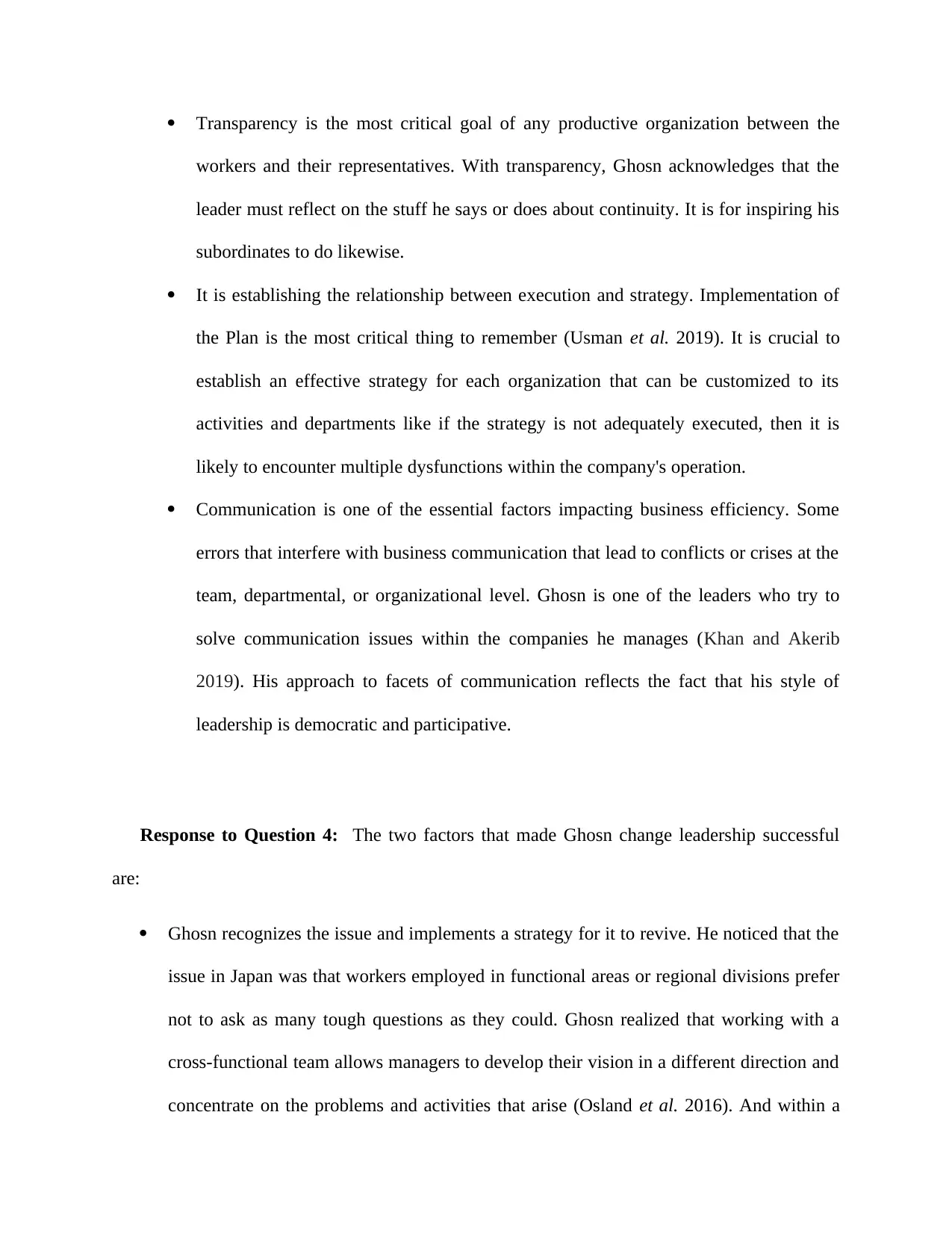
Transparency is the most critical goal of any productive organization between the
workers and their representatives. With transparency, Ghosn acknowledges that the
leader must reflect on the stuff he says or does about continuity. It is for inspiring his
subordinates to do likewise.
It is establishing the relationship between execution and strategy. Implementation of
the Plan is the most critical thing to remember (Usman et al. 2019). It is crucial to
establish an effective strategy for each organization that can be customized to its
activities and departments like if the strategy is not adequately executed, then it is
likely to encounter multiple dysfunctions within the company's operation.
Communication is one of the essential factors impacting business efficiency. Some
errors that interfere with business communication that lead to conflicts or crises at the
team, departmental, or organizational level. Ghosn is one of the leaders who try to
solve communication issues within the companies he manages (Khan and Akerib
2019). His approach to facets of communication reflects the fact that his style of
leadership is democratic and participative.
Response to Question 4: The two factors that made Ghosn change leadership successful
are:
Ghosn recognizes the issue and implements a strategy for it to revive. He noticed that the
issue in Japan was that workers employed in functional areas or regional divisions prefer
not to ask as many tough questions as they could. Ghosn realized that working with a
cross-functional team allows managers to develop their vision in a different direction and
concentrate on the problems and activities that arise (Osland et al. 2016). And within a
workers and their representatives. With transparency, Ghosn acknowledges that the
leader must reflect on the stuff he says or does about continuity. It is for inspiring his
subordinates to do likewise.
It is establishing the relationship between execution and strategy. Implementation of
the Plan is the most critical thing to remember (Usman et al. 2019). It is crucial to
establish an effective strategy for each organization that can be customized to its
activities and departments like if the strategy is not adequately executed, then it is
likely to encounter multiple dysfunctions within the company's operation.
Communication is one of the essential factors impacting business efficiency. Some
errors that interfere with business communication that lead to conflicts or crises at the
team, departmental, or organizational level. Ghosn is one of the leaders who try to
solve communication issues within the companies he manages (Khan and Akerib
2019). His approach to facets of communication reflects the fact that his style of
leadership is democratic and participative.
Response to Question 4: The two factors that made Ghosn change leadership successful
are:
Ghosn recognizes the issue and implements a strategy for it to revive. He noticed that the
issue in Japan was that workers employed in functional areas or regional divisions prefer
not to ask as many tough questions as they could. Ghosn realized that working with a
cross-functional team allows managers to develop their vision in a different direction and
concentrate on the problems and activities that arise (Osland et al. 2016). And within a
Paraphrase This Document
Need a fresh take? Get an instant paraphrase of this document with our AI Paraphraser
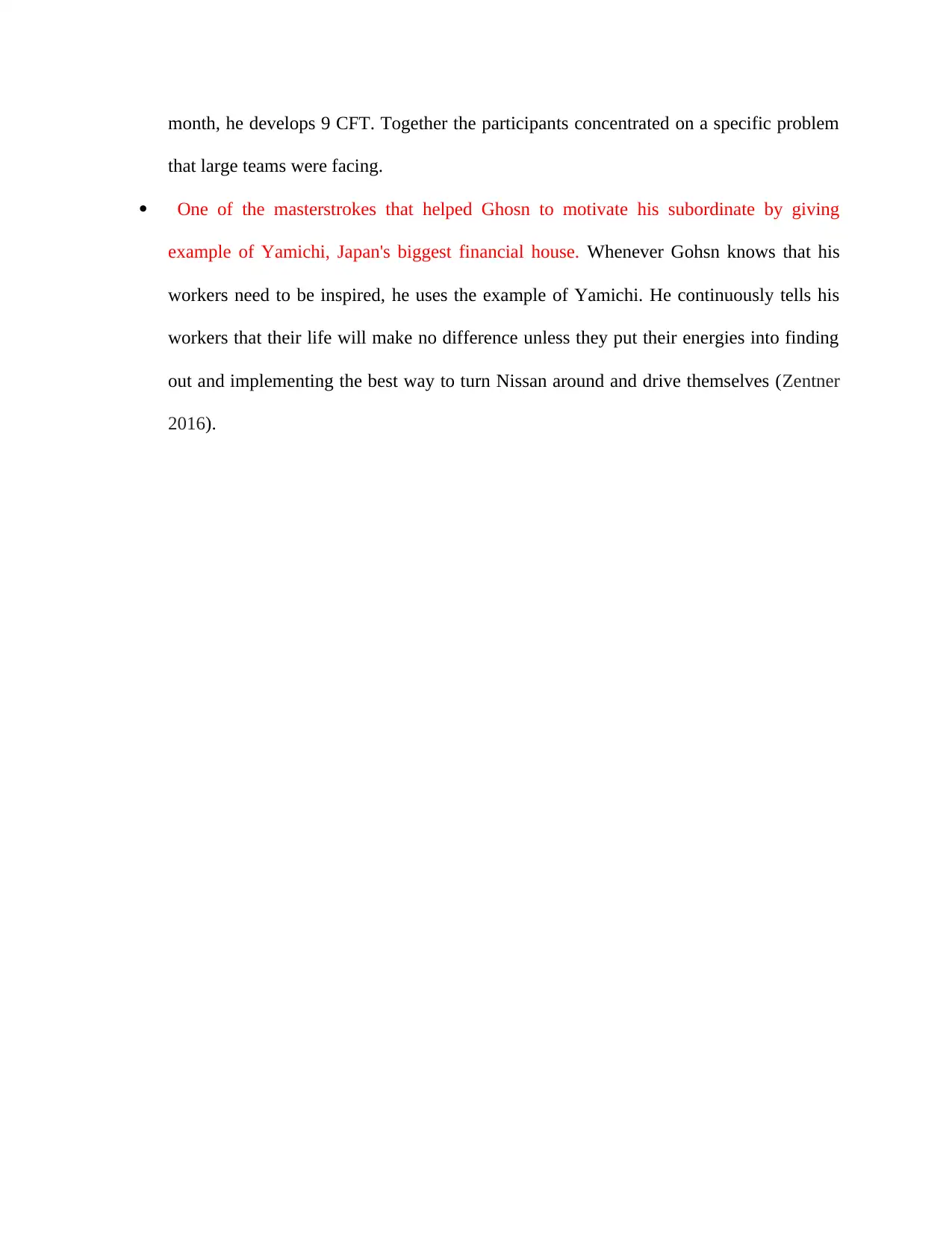
month, he develops 9 CFT. Together the participants concentrated on a specific problem
that large teams were facing.
One of the masterstrokes that helped Ghosn to motivate his subordinate by giving
example of Yamichi, Japan's biggest financial house. Whenever Gohsn knows that his
workers need to be inspired, he uses the example of Yamichi. He continuously tells his
workers that their life will make no difference unless they put their energies into finding
out and implementing the best way to turn Nissan around and drive themselves (Zentner
2016).
that large teams were facing.
One of the masterstrokes that helped Ghosn to motivate his subordinate by giving
example of Yamichi, Japan's biggest financial house. Whenever Gohsn knows that his
workers need to be inspired, he uses the example of Yamichi. He continuously tells his
workers that their life will make no difference unless they put their energies into finding
out and implementing the best way to turn Nissan around and drive themselves (Zentner
2016).
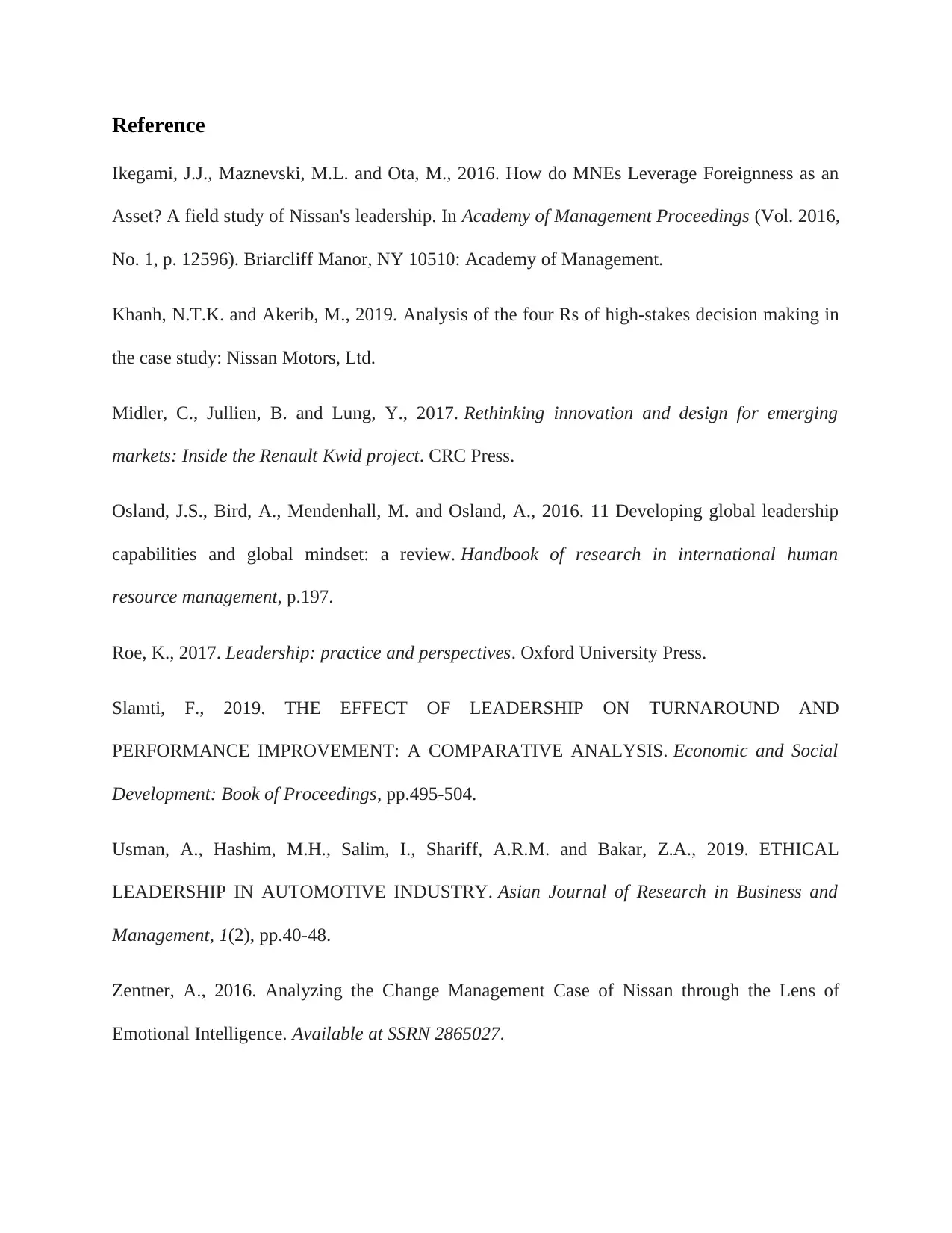
Reference
Ikegami, J.J., Maznevski, M.L. and Ota, M., 2016. How do MNEs Leverage Foreignness as an
Asset? A field study of Nissan's leadership. In Academy of Management Proceedings (Vol. 2016,
No. 1, p. 12596). Briarcliff Manor, NY 10510: Academy of Management.
Khanh, N.T.K. and Akerib, M., 2019. Analysis of the four Rs of high-stakes decision making in
the case study: Nissan Motors, Ltd.
Midler, C., Jullien, B. and Lung, Y., 2017. Rethinking innovation and design for emerging
markets: Inside the Renault Kwid project. CRC Press.
Osland, J.S., Bird, A., Mendenhall, M. and Osland, A., 2016. 11 Developing global leadership
capabilities and global mindset: a review. Handbook of research in international human
resource management, p.197.
Roe, K., 2017. Leadership: practice and perspectives. Oxford University Press.
Slamti, F., 2019. THE EFFECT OF LEADERSHIP ON TURNAROUND AND
PERFORMANCE IMPROVEMENT: A COMPARATIVE ANALYSIS. Economic and Social
Development: Book of Proceedings, pp.495-504.
Usman, A., Hashim, M.H., Salim, I., Shariff, A.R.M. and Bakar, Z.A., 2019. ETHICAL
LEADERSHIP IN AUTOMOTIVE INDUSTRY. Asian Journal of Research in Business and
Management, 1(2), pp.40-48.
Zentner, A., 2016. Analyzing the Change Management Case of Nissan through the Lens of
Emotional Intelligence. Available at SSRN 2865027.
Ikegami, J.J., Maznevski, M.L. and Ota, M., 2016. How do MNEs Leverage Foreignness as an
Asset? A field study of Nissan's leadership. In Academy of Management Proceedings (Vol. 2016,
No. 1, p. 12596). Briarcliff Manor, NY 10510: Academy of Management.
Khanh, N.T.K. and Akerib, M., 2019. Analysis of the four Rs of high-stakes decision making in
the case study: Nissan Motors, Ltd.
Midler, C., Jullien, B. and Lung, Y., 2017. Rethinking innovation and design for emerging
markets: Inside the Renault Kwid project. CRC Press.
Osland, J.S., Bird, A., Mendenhall, M. and Osland, A., 2016. 11 Developing global leadership
capabilities and global mindset: a review. Handbook of research in international human
resource management, p.197.
Roe, K., 2017. Leadership: practice and perspectives. Oxford University Press.
Slamti, F., 2019. THE EFFECT OF LEADERSHIP ON TURNAROUND AND
PERFORMANCE IMPROVEMENT: A COMPARATIVE ANALYSIS. Economic and Social
Development: Book of Proceedings, pp.495-504.
Usman, A., Hashim, M.H., Salim, I., Shariff, A.R.M. and Bakar, Z.A., 2019. ETHICAL
LEADERSHIP IN AUTOMOTIVE INDUSTRY. Asian Journal of Research in Business and
Management, 1(2), pp.40-48.
Zentner, A., 2016. Analyzing the Change Management Case of Nissan through the Lens of
Emotional Intelligence. Available at SSRN 2865027.
⊘ This is a preview!⊘
Do you want full access?
Subscribe today to unlock all pages.

Trusted by 1+ million students worldwide
1 out of 6
Related Documents
Your All-in-One AI-Powered Toolkit for Academic Success.
+13062052269
info@desklib.com
Available 24*7 on WhatsApp / Email
![[object Object]](/_next/static/media/star-bottom.7253800d.svg)
Unlock your academic potential
Copyright © 2020–2025 A2Z Services. All Rights Reserved. Developed and managed by ZUCOL.





